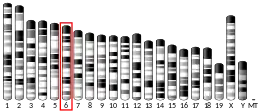STK38L
Serine/threonine-protein kinase 38-like is an enzyme that in humans is encoded by the STK38L gene.[5][6]
References
- GRCh38: Ensembl release 89: ENSG00000211455 - Ensembl, May 2017
- GRCm38: Ensembl release 89: ENSMUSG00000001630 - Ensembl, May 2017
- "Human PubMed Reference:". National Center for Biotechnology Information, U.S. National Library of Medicine.
- "Mouse PubMed Reference:". National Center for Biotechnology Information, U.S. National Library of Medicine.
- Suzuki A, Ogura T, Esumi H (May 2006). "NDR2 acts as the upstream kinase of ARK5 during insulin-like growth factor-1 signaling". J Biol Chem. 281 (20): 13915–21. doi:10.1074/jbc.M511354200. PMID 16488889.
- "Entrez Gene: STK38L serine/threonine kinase 38 like".
Further reading
- Nakajima D, Okazaki N, Yamakawa H, et al. (2003). "Construction of expression-ready cDNA clones for KIAA genes: manual curation of 330 KIAA cDNA clones". DNA Res. 9 (3): 99–106. doi:10.1093/dnares/9.3.99. PMID 12168954.
- Nagase T, Ishikawa K, Suyama M, et al. (1999). "Prediction of the coding sequences of unidentified human genes. XIII. The complete sequences of 100 new cDNA clones from brain which code for large proteins in vitro". DNA Res. 6 (1): 63–70. doi:10.1093/dnares/6.1.63. PMID 10231032.
- Strausberg RL, Feingold EA, Grouse LH, et al. (2003). "Generation and initial analysis of more than 15,000 full-length human and mouse cDNA sequences". Proc. Natl. Acad. Sci. U.S.A. 99 (26): 16899–903. doi:10.1073/pnas.242603899. PMC 139241. PMID 12477932.
- Stegert MR, Tamaskovic R, Bichsel SJ, et al. (2004). "Regulation of NDR2 protein kinase by multi-site phosphorylation and the S100B calcium-binding protein". J. Biol. Chem. 279 (22): 23806–12. doi:10.1074/jbc.M402472200. PMID 15037617.
- Devroe E, Erdjument-Bromage H, Tempst P, Silver PA (2004). "Human Mob proteins regulate the NDR1 and NDR2 serine-threonine kinases". J. Biol. Chem. 279 (23): 24444–51. doi:10.1074/jbc.M401999200. PMID 15067004.
- Bichsel SJ, Tamaskovic R, Stegert MR, Hemmings BA (2005). "Mechanism of activation of NDR (nuclear Dbf2-related) protein kinase by the hMOB1 protein". J. Biol. Chem. 279 (34): 35228–35. doi:10.1074/jbc.M404542200. PMID 15197186.
- Jin J, Smith FD, Stark C, et al. (2004). "Proteomic, functional, and domain-based analysis of in vivo 14-3-3 binding proteins involved in cytoskeletal regulation and cellular organization". Curr. Biol. 14 (16): 1436–50. doi:10.1016/j.cub.2004.07.051. PMID 15324660. S2CID 2371325.
- Gerhard DS, Wagner L, Feingold EA, et al. (2004). "The status, quality, and expansion of the NIH full-length cDNA project: the Mammalian Gene Collection (MGC)". Genome Res. 14 (10B): 2121–7. doi:10.1101/gr.2596504. PMC 528928. PMID 15489334.
- Devroe E, Silver PA, Engelman A (2005). "HIV-1 incorporates and proteolytically processes human NDR1 and NDR2 serine-threonine kinases". Virology. 331 (1): 181–9. doi:10.1016/j.virol.2004.10.023. PMID 15582665.
- Stegert MR, Hergovich A, Tamaskovic R, et al. (2006). "Regulation of NDR protein kinase by hydrophobic motif phosphorylation mediated by the mammalian Ste20-like kinase MST3". Mol. Cell. Biol. 25 (24): 11019–29. doi:10.1128/MCB.25.24.11019-11029.2005. PMC 1316964. PMID 16314523.
- Ewing RM, Chu P, Elisma F, et al. (2007). "Large-scale mapping of human protein-protein interactions by mass spectrometry". Mol. Syst. Biol. 3 (1): 89. doi:10.1038/msb4100134. PMC 1847948. PMID 17353931.
This article is issued from Wikipedia. The text is licensed under Creative Commons - Attribution - Sharealike. Additional terms may apply for the media files.




